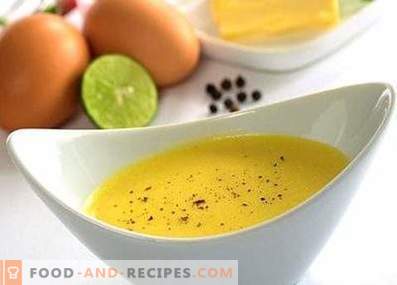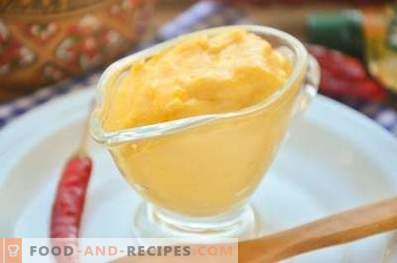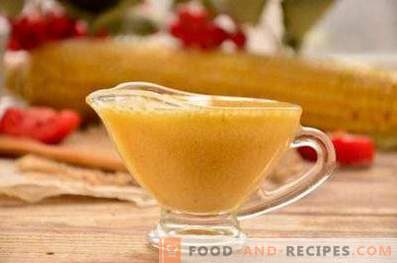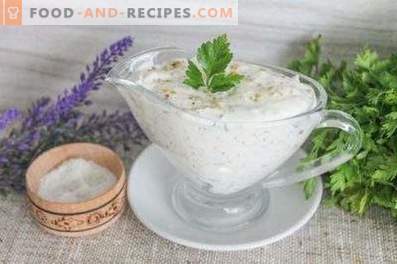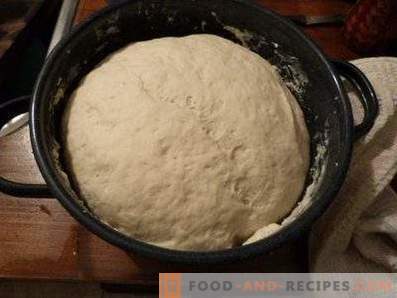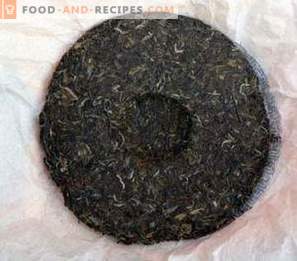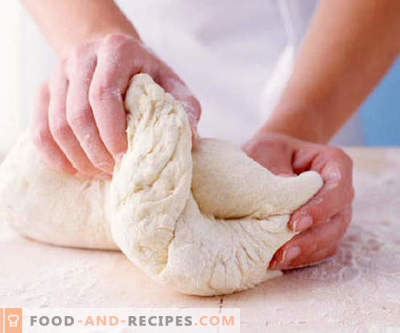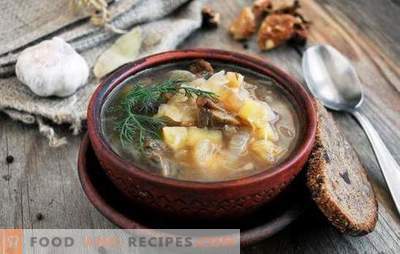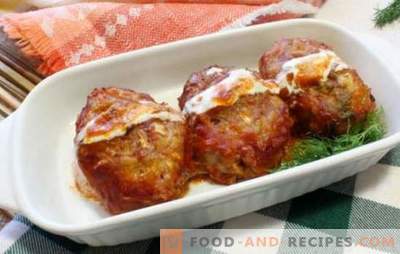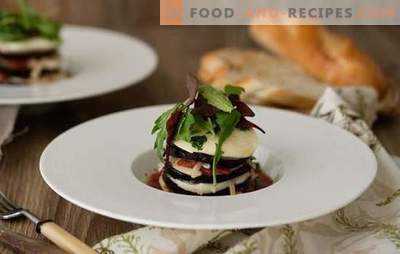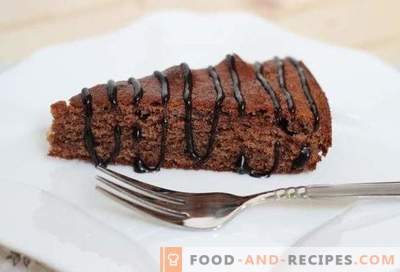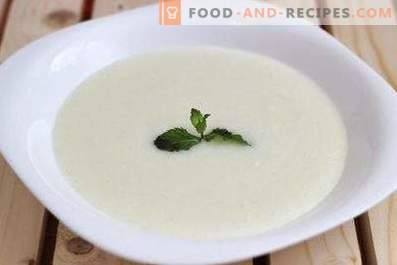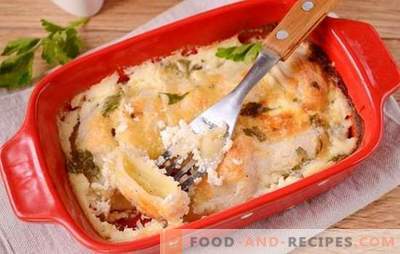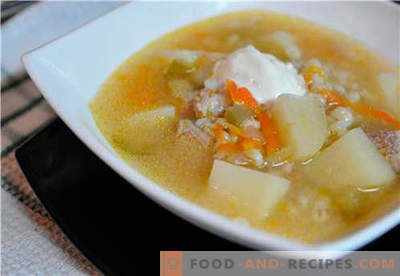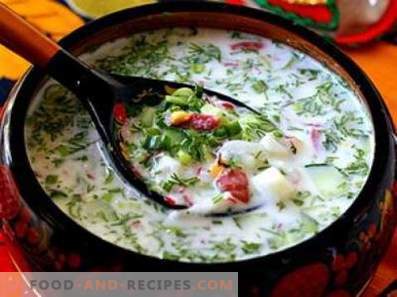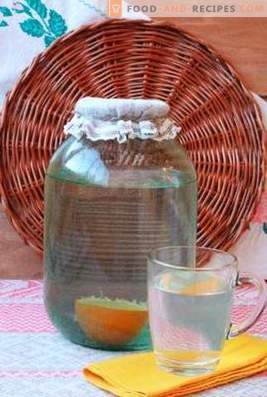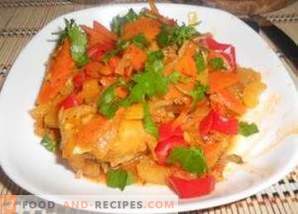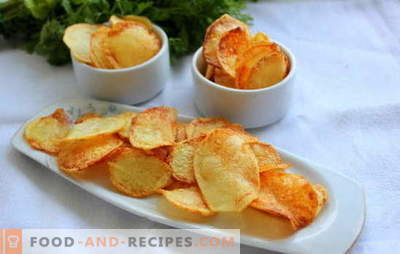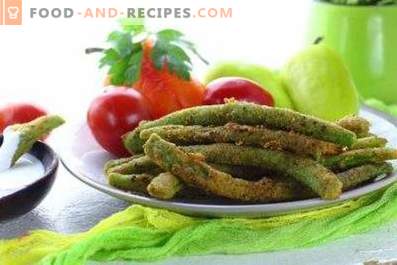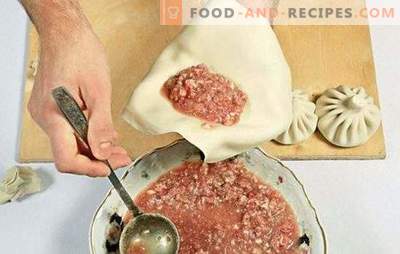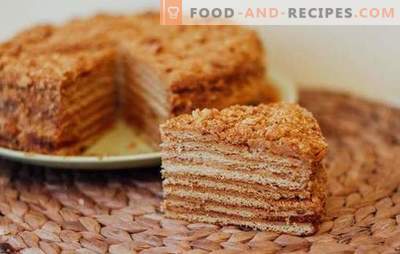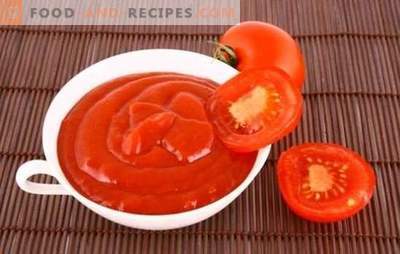
Despite the fact that mayonnaise was invented in France, our compatriots accepted and loved this sauce as their own. It is added to salads, with it baked meat and fish. Some even know how to cook mayonnaise pies. This sauce is served to the table to absolutely any dishes, smeared on sandwiches. However, most housewives do not know how to cook this French sauce, buying it in a store where there is a risk to purchase a product of the highest quality. Meanwhile, mayonnaise at home is not difficult to do, and the cooking process does not take much time. If all the housewives knew the appropriate recipes and the technology of mayonnaise, they probably would prefer a homemade sauce.
Cooking Features
The culinary skill can be estimated by how tasty and fragrant sauces he can cook. This is true when it comes to sauce, the cooking technology of which is distinguished by a high degree of complexity, but not to mayonnaise. Even a novice cook can make homemade mayonnaise; he just needs to find a recipe and use the advice of experienced chefs.
- For homemade mayonnaise, it is better to take homemade eggs, the freshness and quality of which you are 100% sure of. Otherwise, there is a risk of infection with salmonellosis, because for the preparation of mayonnaise use raw eggs, or rather their yolks. In addition, in eggs of domestic chickens or laying hens, grown in farms, there are usually bright yolks, thanks to which mayonnaise gets an appetizing creamy tint. An additional advantage of such eggs is their higher content of vitamins and microelements.
- If you have to use store eggs for making mayonnaise, then you need to wash them thoroughly, this will minimize the risk of infection, since salmonella may be in chicken litter, and therefore on the shell, but not in yolk. A pleasant shade of mayonnaise, if desired, can be given with the help of turmeric, but it should be added quite a bit, literally at the tip of a knife, otherwise the color will be too saturated.
- It is best if the products that need to be whipped to make the sauce are the same temperature. The capacity for beating should also be the same temperature, ideally - room temperature. Therefore, all the products that make up the sauce must be removed from the refrigerator in advance.
- In order to get a uniform sauce, the products included in its composition do not mix everything all at once, but gradually: first, beat the yolks. Then they add lemon juice or vinegar, salt and pepper. The oil is injected last and in small portions. If, despite following the right sequence, the sauce is stratified, try increasing the number of eggs. To do this, beat the yolks again, and then in portions, add the sauce that turned out at the beginning into them.
- It will be easier to get a homogeneous sauce if you work with a high-quality whisk. Acceptable and the use of kitchen appliances. If you are using a mixer, first beat the products at low speed. They need to be increased only at the stage of oil introduction.
- Do not use oil with a pronounced smell for mayonnaise. It is better to take olive oil, but the use of sunflower oil is acceptable, as long as it is refined and deodorized.
The only drawback that homemade mayonnaise has in comparison with the purchased one is the short shelf life. If you used a lot of eggs, you need to consume the sauce during the day. When using a small number of eggs, the shelf life of homemade mayonnaise in the refrigerator can be increased to two days. For this reason, it is not necessary to harvest mayonnaise for the future - do as much as you have time to eat. If the recipe contains too many ingredients, they can be reduced, but be sure to keep the proportions.
Classic mayonnaise recipe
Calorie dishes: 2531 kcal, per 100 g: 590 kcal.
Composition:
- vegetable oil - 0, 25 l;
- chicken eggs - 2-3 pcs .;
- table vinegar (9 percent) - 5 ml;
- salt - 3-4 g;
- sugar - 5 g.
Method of preparation:
- Wash eggs thoroughly in warm running water and soap. Wipe with a clean cloth.
- Separate yolks from proteins. For mayonnaise, only yolks are required, whites can be used to prepare any other dish.
- Add salt and sugar to yolks. Whisk them. Beat until yolks turn white.
- While continuing to beat, pour in the vinegar.
- Beating, add butter. You need to enter gradually, in a tablespoon, adding a new one only after the previous one is completely dissolved.
It remains to cool the sauce, pour into a sauceboat and serve. Classic mayonnaise can also be used to prepare any dishes, including as the main sauce for sauces with other flavors. This will happen, for example, if you add some garlic cloves crushed by a press, mustard, and ketchup into mayonnaise.
Mayonnaise “Provence”
Caloric content of the dish: 2003 kcal, per 100 g: 591 kcal.
Composition:
- vegetable oil (preferably olive oil) - 0, 2 l;
- mustard (Dijon is better) - 5 ml;
- chicken egg - 2 pcs .;
- salt - 3-4 g;
- sugar - 5 g;
- wine vinegar (3 percent) - 15 ml.
Method of preparation:
- Break the washed eggs, separating the yolks from the proteins.
- Beat the yolks with a whisk, adding salt and sugar to them, until a light shade is obtained.
- Add mustard. Beat until the mass becomes homogeneous.
- Gradually add the butter, whipping or stirring the sauce all the time.
- Pour in vinegar. Beat another 5 minutes.
Mayonnaise “Provence” has a more savory taste in comparison with the classic version due to the addition of mustard.
Mayonnaise with lemon juice
Caloric value of the dish: 2022 kcal, per 100 g: 449 kcal.
Composition:
- vegetable oil - 0, 2 l;
- lemon - 1 pc .;
- chicken egg - 2 pcs .;
- salt - a pinch;
- sugar - 5 g;
- mustard (optional) - 5 ml.
Method of preparation:
- Wash the eggs. Separate the yolks and place in a clean bowl.
- Wash lemon. Cut it in half. In a clean bowl, squeeze the juice out of it and strain it.
- Pour salt and sugar in a bowl with yolks. Beat them - the mass should lighten up.
- Add the mustard, beat until completely dissolved.
- Pour in lemon juice. Beat until the mass is completely homogeneous.
- Beat by adding butter in small portions until the oil runs out and the sauce has a uniform consistency.
The mayonnaise prepared according to this recipe is much better than the classic one for fish and for some types of vegetable salads.
Mayonnaise on quail eggs
Caloric content of a dish: 2411 kcal, per 100 g: 695 kcal.
Composition:
- vegetable oil - 0, 25 l;
- quail eggs - 6 pcs .;
- apple cider vinegar (6 percent) - 10 ml;
- mustard powder - 5 g;
- sugar - 5 g;
- salt - a pinch.
Method of preparation:
- Wash and break quail eggs into a bowl. Yolks from proteins do not need to be separated - according to this recipe, eggs are used entirely.
- Add salt and sugar to eggs. Beat them with a whisk or mixer until they are light.
- Add mustard diluted with vinegar. Beat for 2-3 minutes.
- Pour a tablespoon of oil, whisk until smooth. Add another spoonful of butter and whisk again. Continue adding the butter, whipping the sauce at the same time until the butter runs out.
Some people consider this mayonnaise recipe to be a dietary one, but this is a mistaken opinion - its caloric content is not much less than that of the classic one.
Low-calorie mayonnaise
Caloric content of the dish: 1289 kcal, per 100 g: 335 kcal.
Composition:
- vegetable oil - 100 ml;
- low-fat sour cream or unsweetened yoghurt - 100 ml;
- lemon juice - 10 ml;
- chicken egg - 3 pcs .;
- salt - a pinch;
- low-calorie sweetener - in an amount equivalent to 5 g of sugar.
Method of preparation:
- Boil the eggs, remove the yolks and mash them with a fork.
- Add to the yolks salt, sugar dissolved in the minimum amount of water, sweetener and lemon juice. Pound carefully.
- Add sour cream and stir or whisk until smooth.
- Enter the butter in small pieces, whilst continuing to whip the sauce with a whisk or mixer.
This mayonnaise will be about one and a half times less caloric than the traditional one. But if you wish, you can find a more dietary option.
Dietary mayonnaise
Calorie dishes: 191 kcal, per 100 g: 87 kcal.
Composition:
- Greek yogurt - 150 ml;
- chicken egg - 1 pc .;
- lemon juice - 5 ml;
- mustard - 2-3 ml;
- pepper - on the tip of a knife;
- salt - a pinch.
Method of preparation:
- Cook a hard boiled egg, cool, peel. Remove the yolk from the egg and place it in a small bowl.
- Carefully knead the yolk with a fork.
- Add mustard to the yolk, add pepper and salt, pour in lemon juice and rub it thoroughly to ensure that the consistency is even.
- Put the unsweetened yogurt in the yolk bowl. Stir well with a spoon, then lightly whisk with a whisk or mixer.
The sauce prepared according to this recipe, which resembles a real one in taste and appearance, may well be called a useful product. He will not harm your figure. So if you like mayonnaise, but cannot afford to eat fatty foods, you should pay attention to this recipe.
Lean Mayonnaise
Caloric content of the dish: 1054 kcal, per 100 g: 405 kcal.
Composition:
- potato starch - 40 g;
- vegetable oil - 100 ml;
- vegetable broth - 100 ml;
- lemon juice - 5 ml;
- mustard - 5 ml;
- sugar - a pinch;
- salt - a pinch.
Method of preparation:
- Pour 100 ml of broth, cooling it to room temperature. Dissolve starch.
- Lightly heat the remaining broth, pour a thin stream of broth with starch, stir. As soon as the broth begins to thicken, remove it from the heat, cool.
- Add mustard, salt, sugar, lemon juice to broth. Whisk.
- Continuing to beat, gradually add vegetable oil.
Mayonnaise made according to this recipe can be served on the table in the post. It is worth paying attention to it and vegetarians.
Video: homemade mayonnaise, 3 recipes
Video: top 5 recipes for lean mayonnaise!
Even an inexperienced hostess can cook mayonnaise at home, if only she strictly adheres to the technology. In addition to the classic recipe, you can use its variations, which make the sauce more savory taste or reduce its calorie content.
